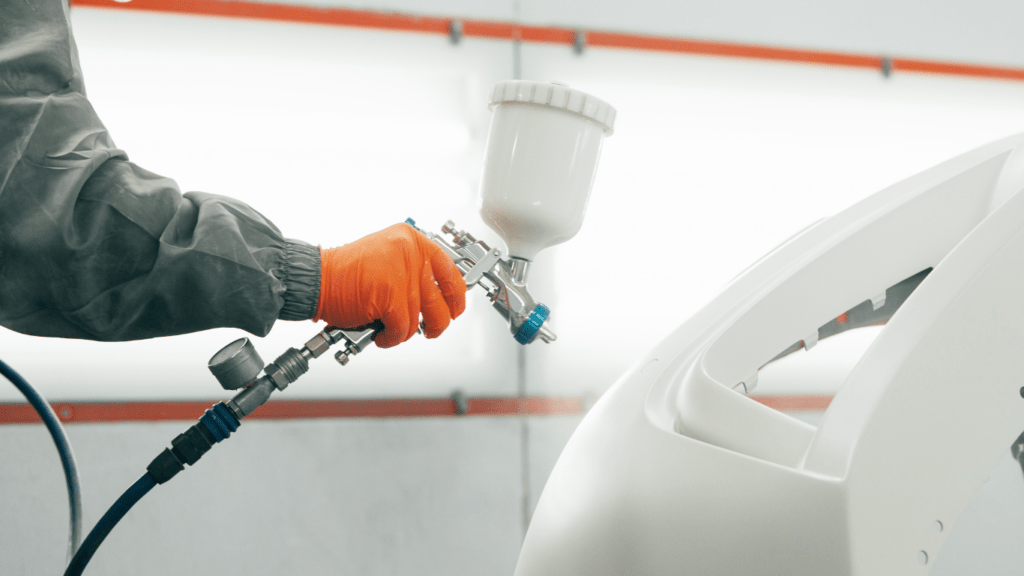Essential Equipment for Car Painting and Bodywork
Having the right equipment is crucial for achieving a flawless finish in car painting and bodywork. High-quality tools ensure precision and durability, making the process efficient.
Safety Gear
Safety gear is essential for protecting yourself during car painting and bodywork. Wear a respirator with proper filters to avoid inhaling harmful fumes.
Use nitrile gloves to protect your skin from chemicals and solvents. Wear safety goggles to shield your eyes from splashes and flying debris. A durable, fire-resistant coverall guards against paint and chemical splashes.
Painting Tools and Materials
For painting, a high-quality spray gun ensures even application. Use a dual-action airbrush for detailed work. A paint mixing system guarantees color accuracy.
Paint strainers filter out impurities, ensuring a smooth finish. Invest in high-quality automotive paint and primers for durability. Sandpapers of various grits, from 400 to 2000, are necessary for surface preparation and smoothing.
Bodywork Repair Tools
Bodywork repair tools are critical for fixing dents and imperfections. Use a hammer and dolly set for shaping metal. A body filler and applicator smooth out dents and scratches.
A stud welder helps repair larger dents by pulling them out. For surface finishing, use an orbital sander. A quality compressor powers pneumatic tools efficiently.
Importance of Choosing the Right Equipment

Selecting the right equipment for car painting and bodywork determines the efficiency and end quality of the work. High-grade tools also enhance safety and reduce long-term costs.
Quality vs. Cost
Quality tools often come with a higher price tag but bring longevity and reliability. For example, a professional-grade spray gun ensures precise paint application, minimizing waste and rework.
Conversely, cheaper tools may save money upfront but frequently break or wear out, leading to higher replacement costs and inconsistent results.
Investing in quality equipment saves money in the long haul by reducing downtime and materials wastage.
The Impact on Final Results
- The right tools directly affect the final appearance of the painted vehicle.
- Premium tools like high-quality sandpapers create smoother surfaces, facilitating better paint adhesion.
- Proper bodywork tools, such as stud welders and hammer and dolly sets, ensure dents and imperfections are effectively fixed, resulting in a flawless finish.
- Inaccurate or low-quality tools can introduce flaws that detract from the vehicle’s overall look, compromising customer satisfaction.
Setting Up Your Workspace
Creating the perfect workspace is essential for achieving top-quality car painting and bodywork. Optimize both your environment and tool setup for the best results.
Creating a Controlled Environment
Ensure the workspace is clean and well-ventilated. Install proper air filtration systems to remove dust and contaminants.
Maintain a consistent temperature using heaters or air conditioners for optimal paint curing. Isolate the painting area with plastic sheeting to minimize airborne particles.
Organizing Tools for Efficiency
Arrange tools logically for easy access. Use pegboards or tool racks to keep supplies visible and within reach. Label storage bins for different consumables like:
- sandpapers
- masking tapes
- paint mixing cups
Position frequently used tools, such as spray guns and sanders, near the work area to reduce downtime. Keep a dedicated space for safety gear to ensure it’s always ready for use.
Maintenance and Care of Equipment
Proper maintenance ensures equipment longevity and optimal performance. Routine care reduces the risk of malfunctions and preserves the quality of car painting and bodywork.
Regular Cleaning Routines
Cleaning tools after every use is crucial. For spray guns, disassemble and clean every component with a solvent. For sandpapers, thoroughly shake out dust or use compressed air.
Regularly wiping down hammer and dolly sets and lubricating moving parts prevent rust and wear. Keeping workspaces clean, including wiping down the surfaces, minimizes contamination in paint jobs and prolongs the life of equipment.
Monitoring and Replacing Worn Parts
Inspect tools for wear and tear before every use. Replace worn spray gun nozzles to maintain precise paint application. Check sandpapers for grit degradation and discard ineffective sheets.
Examine hammer and dolly faces for damage and replace if surfaces become uneven. Timely replacement of worn parts ensures consistent performance and avoids compromising the quality of work.

